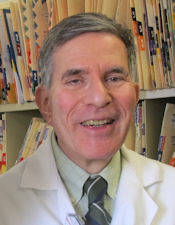By Kate Madden Yee, AuntMinnie.com staff writer
September 5, 2022 — SAN FRANCISCO - The development of personalized breast screening protocols shouldn’t result in more restrictive screening policies in which women are screened less frequently and at older ages, according to a talk by Dr. Stephen Feig at the American Society of Clinical Oncology (ASCO) Breast Cancer Symposium.
“Personalized screening means different things to different people,” said Feig, chief of breast imaging at the University of California, Irvine. “For radiologists, it means annual screening starting at age 40, with supplementary MRI, breast ultrasound, or tomosynthesis for women at higher risk or with dense breast tissue. But for healthcare planners, the term means the opposite: that women with average or lower than average risk should be screened less often — every two, three, or even four years.”
The problem, according to Feig, is that 20% of breast cancer deaths occur in women diagnosed in their 40s, and 61% of women in this age group with screen-detected breast cancer have no family history of the disease.
Screening scenarios
In his talk, Feig walked session attendees through the state of current clinical research, comparing various scenarios for how often screening should take place and when it should start.
For example, one more conservative protocol calls for only screening high-risk women in their 40s, which would result in 30% of women in that age group being screened. The protocol would screen all women in their 50s, but most only every other year. For women in their 70s, half wouldn’t be screened at all and the other half would be screened biennially.
 Dr. Stephen Feig from the University of California, Irvine.
Dr. Stephen Feig from the University of California, Irvine.
Such a scheme is not unlike the U.S. Preventive Services Task Force (USPSTF) 2009 recommendations, which state that women between the ages of 40 and 49 should only be screened if they are high risk, women between 50 and 74 should be screened every other year, and women 75 and older should not be screened at all.
But the fly in the ointment with such conservative protocols is the fact that when screening starts at age 40 and continues annually, the mortality reduction of 39.5% is greater than the 23.2% mortality reduction realized when the USPSTF recommendations are followed. Thus, more frequent screening results in 71% more lives saved.
“That means almost 100,000 more lives are saved, if all women comply,” Feig said. “At our current compliance rate of 65%, it would be about 65,000 more lives saved. In fact, about 40% of the years of life lost from breast cancer are associated with cases diagnosed between the ages of 40 and 49.”
Breast cancer incidence is age-dependent, he said, but the number needed to screen to detect one cancer or save one life among women ages 40 to 49 is reasonable. And the benefit doesn’t end when a woman turns 70.
“There’s no reason to think that the benefit of annual screening won’t continue as long as a woman has a reasonable life expectancy,” Feig said. “Women at age 70 have a life expectancy of 15 years, at age 80, nine years, and at age 90, five years. If women with significant comorbidity are excluded from the calculations, the life expectancy is even higher.”
Also, the size of the tumor matters, according to Feig: It’s not enough to assess screening’s efficacy by evaluating stage alone.
“It’s too crude today to only look at late-stage versus less-late-stage,” he said. “We can’t compare screening effectiveness on the basis of node status alone. We have to look at tumor size as well, since the larger the tumor, the lower the survival rates. Regular screening not only decreases the likelihood that a cancer will be found, it also reduces the stage of disease.”
Keep harms in perspective
What about the harms of screening mammography, such as overdiagnosis, inflated recall rates, false positives, and radiation risk? We need to keep all these factors in perspective, according to Feig.
“These alleged risks of screening can’t be compared to the risk of not screening — which could lead to death from breast cancer,” he said. “Overdiagnosis is way overestimated. It’s probably about 5% of cases, rather than 30%, as has been reported, if the calculations are made correctly, accounting for lead time and risk status.”
As for financial harms, the costs of screening mammography fall in line with other commonly accepted interventions, although Feig conceded that screening would be conducted more than other treatments such as antihypertension drugs or dialysis.
The cost of annual screening mammography for women ages 40 to 60 is about $17,000 per life-year gained, a reasonable and lower amount than other interventions, such as coronary bypass at $28,000 per life-year gained or the use of seatbelts and airbags in cars at $32,000 per life-year gained, he said.
Cutting-edge screening?
What’s at the cutting edge of breast cancer screening? The tracking of single nucleotide polymorphisms (SNPs), which are common gene variants that affect risk, according to Feig.
“Eight percent of familial breast cancers are attributed to SNPs,” he said. “Today, there are 76 validated SNPs, and we need to assess their potential implications for future screening guidelines.”
The benefits of screening mammography have been proved in randomized clinical trials such as the Swedish Two-County trial, which found a 31% mortality reduction in women between the ages of 40 and 74 — and this reduction has persisted during follow-up of more than 30 years, Feig said.
“And because for these trials the screening intervals were longer than ideal, the trial lengths were too short, and they used older technology, I would submit that we can do even better today,” he concluded.
Copyright © 2014 AuntMinnie.com
